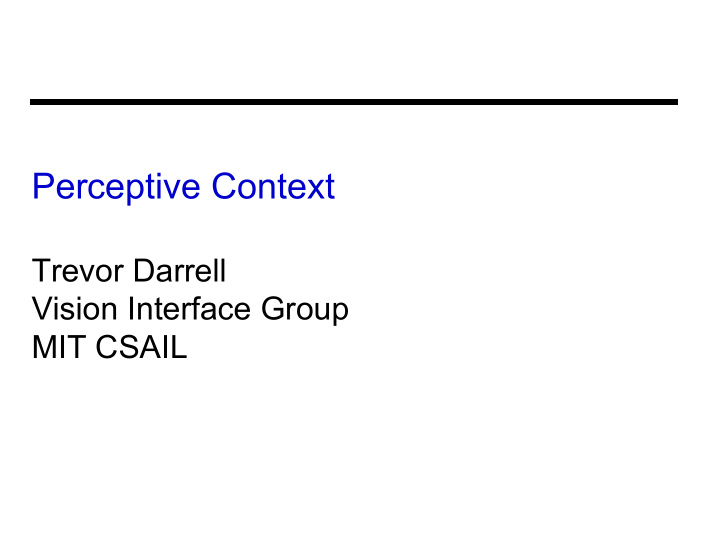



Perceptive Context Trevor Darrell Vision Interface Group MIT CSAIL
Perceptive Context Awareness of the User -- Visual Conversation Cues: Interfaces (kiosks, agents, robots…) are currently blind to users…machines should be aware of presence, pose, expression, and non-verbal dialog cues… Awareness of the Environment -- Perceptive Devices: Mobile devices (cellphones, PDAs, laptops) bring computing and communications with us wherever we go, but they are blind to their environment…they should be able to see things of interest in the environment just as we do…
Today • Visually aware conversational interfaces (“ read my body language!”) - head modeling and pose estimation - articulated body tracking • Mobile devices that can see their environment (“ what’s that thing there?”) - mobile location specification - image-based mobile web browsing
Head modeling and pose tracking
3D Head Pose Tracker rigid stereo Stereo camera motion estimation range Current frame intensity Reference frame
Face aware interfaces • Agent should know when it’s being attended to • Turn-taking discourse cues: who is talking to whom? • Model attention of user • Agreement: head nod and shake gestures • Grounding: shared physical reference
Face cursor
Face-responsive agent Subject not looking at SAM: ASR turned off SAM Pose tracker
Face-responsive agent Subject looking at SAM: ASR turned on SAM Pose tracker
Face-responsive agent Subject not looking at SAM: ASR turned off SAM Pose tracker
Face-responsive agent Subject looking at SAM: ASR turned on SAM Pose tracker
Face-responsive agent Subject looking at SAM: ASR turned on SAM • General conversational turn-taking • Agreement (Nod/Shake) Pose tracker • Grounding / Object reference…
Room tracking for Location Context Location is an important cue for pervasive computing applications… • Location context should provide a finer scale cue than room-ID, but more abstract than 3-space position and orientation. • Regions (“zones”) should be learned from observing actual user behavior. Plan view Foreground Room Range
Learning activity zones Plan view Foreground Room Range Motion Clustering Activity zones Zone map formed from observing user behavior
Using activity zones Plan view Foreground Room Range zone 4 prefs Activity zones Current zone determines application context [Koile, Darrell, et. al, UBICOMP 03]
Articulated pose sensing
Model-based Approach model depth image ICP with articulation constraint 1. Find closest points 2. Update poses 3. Constrain…
Interactive Wall
Multimodal studio
Articulated Pose from a single image? Model based approach difficult with more impoverished observations: - contours - edge features - texture - (noisy stereo…) hard to fit a single image reliably! � Example-based learning paradigm
Example-based matching • Match 2-D features against large corpus of 2-D to 3-D example mappings • Fast hashing for approximate nearest neighbor search • Feature selection using paired classification problem • Data collection: use motion capture data, or exploit synthetic (but realistic) models
Parameter sensitive hashing
2D->3D with Parameter sensitive hashing
Today • Visually aware conversational interfaces -- read my body language! - head modeling and pose estimation - articulated body tracking • Mobile devices that can see their environment -- what’s that thing there? - mobile location specification - image-based mobile web browsing
Physical awareness How can device be aware of what user is looking at? User
Physical awareness Asking a friend, “What’s this?” Human Expert User What is this? MIT Dome
IDeixis Instead, use CBIR (Content-based Image Retrieval) system: User CBIR System What is this? http://mit.edu/..
CBIR: Content-based Image Retrieval • Use image (or video) query to database. • For place recognition, many current matching methods can be successful - PCA - Gobal orientation histograms [Torralba et al.] - Local features (Affine-invariant detectors/descriptors [Schmid], SIFT [Lowe], etc.) … where to get the database?
The Web • Many location images can be found on the web
First Prototype 1. Take an Image 2. Send image via 3. View search result MMS (matching location 4. Browse a relevant webpage images)
Images -> keywords (-> images) • Hard to compile an image database of entire web! • But given matches in subset of web: - Extract salient keywords - Keyword-based image search - Apply content-based filter to keyword-matched pages • And/or allow direct keyword search • Weighted term/bigram frequency sufficient for early experiments…
Bootstrap image web search Web Bootstrap Image Database CBIR (1) (3) (4) Effiel Tower CBIR (2)
Advantages • Recognizing distant location (by taking photo) • Infrastructure free (by using the web) • Large-scale image-based web search (by bootstrapping keywords) • With advances in segmentation, can apply to many other object recognition problems – mobile signs – appliance – product packaging
Visual Interfaces and Devices Interfaces (kiosks, agents, robots…) are currently blind to users…machines should be aware of presence, pose, expression, and non-verbal dialog cues… Mobile devices (cellphones, PDAs, laptops) bring computing and communications with us wherever we go, but they are blind to their environment…they should be able to see things of interest in the environment just as we do…
Acknowledgements David Demirdjian Kimberlie Koile Louis Morency Greg Shakhnarovich Mike Siracusa Konrad Tollmar Tom Yeh & many others…
END
Recommend
More recommend